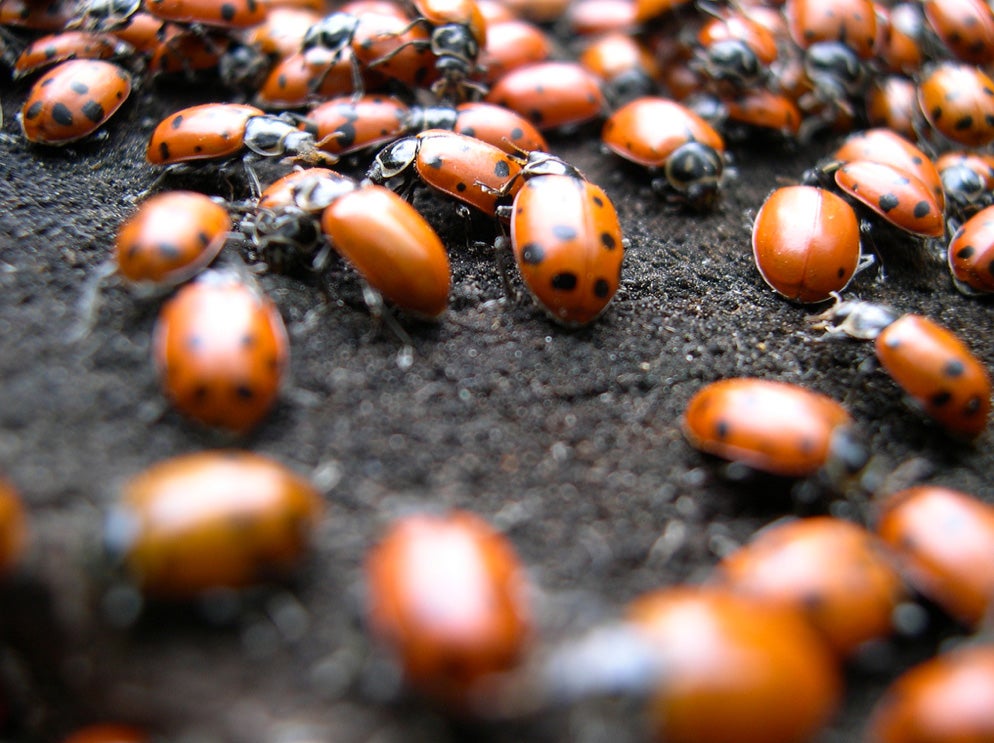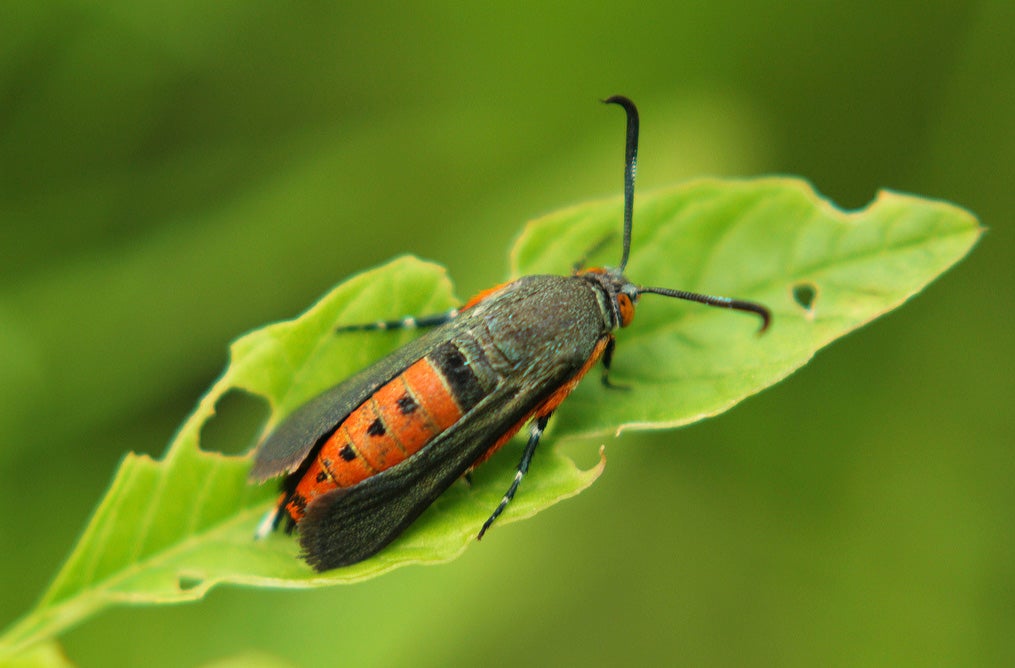Plants that ignite the senses
ListenMike McGrath explains the benefits of ladybugs, how to turn a peach pit into a peach tree, why it’s best to keep straw out of your garden, identifying and eliminating aphids, preparing your lawn for an outdoor wedding, saving squash from the squash vine borer, how to get rid of moles, and what plants work best for the vision impaired.
Question of the Week:
“We bought our first home last year and I’m beginning to plan out our gardens. My wife is completely blind, and I’d like to have plants throughout the garden that she can enjoy. We have a lot of space and plan to stay here awhile; do you have any recommendations for ornamentals, vegetables, herbs, trees or shrubs that have tactile, fragrant or even auditory interest? Fragrant summer flowers are not hard to find; same for common tactile plants like Lamb’s Ear. But I’m hoping for more interest throughout the year and ideas in general. We did hang suet feeders on your recommendation, and as a result, hear great bird songs starting at dawn. But the squirrels are staring to jump onto them.”
— Kai in Boston
Planning a garden for the vision-impaired »
Highlights from show for March 22, 2014:
Saving ladybugs
Marlyn from Franklinville, New Jersey is concerned about ladybugs. Her home has been overrun with them this winter and they aren’t leaving. Since Marlyn knows that ladybugs are an important part of the local environment, she calls Mike to ask how she can safely remove them. Mike is glad to hear that Marlyn cares so much about the beneficial ladybugs: “These multi-colored Asian ladybugs were probably the most common home-invading insect a decade ago … These are all insects that are used to hibernating through the winter in the adult stage in caves or stands of evergreen trees and here in America … as they see that the season is changing they collect themselves on the south side of light-colored homes … These are beneficial insects that were reared, deliberately bred, and then released to control a very specific pest.” To save a community of ladybugs that’s occupying your home you can fill a canister vacuum bag with newspaper and raffia, vacuum the ladybugs into the bag, spray the bag with a mister, and seal the bag and put it in your refrigerator. When it really warms up in the spring, release the ladybugs into your garden after a rainstorm at dusk and they will repay your efforts by keeping your plants pest-free.
“These multi-colored Asian ladybugs were probably the most common home-invading insect a decade ago … These are beneficial insects that were reared, deliberately bred, and then released to control a very specific pest.”
Mike McGrath
-

Photo by Flickr user flash gordon md
From a peach pit to a peach tree
Mike from Edmond, Oklahoma started a peach tree from seed last year. So far it’s growing well in its pot, but he wants advice about caring for and transplanting this fledgling fruit tree. When you grow a peach tree from seed, it takes a few years for the tree to produce fruit and sometimes the grower doesn’t even know the name of the type of peach. Luckily, this peach pit came from a farmer’s market peach and by talking to the farmer, Mike might be able to assign a name to this fruit and gather more specific information. In the meantime, there are a few things he can do to keep his tree healthy. “Here’s what your tree needs: It needs a location where it will get full sun, where it will get morning sun. The morning sun is the most important part. Because you’re in Oklahoma where it gets so blistering hot in the summer in addition to the desiccating winds in your case full sun means shade after two or three o’clock in the afternoon … It needs a place where this wind isn’t whipping up against it all the time and it needs a lot of elbow-room from the other plants.” This year Mike should expect the tree to flower, go through a full season of dormancy next winter, and really take off next year.
Starting a garden: Questions about the straw bale method
Bobbie from Muncie, Indiana recently acquired some vacant lots and wants to start a garden. Since the soil is suspect and the ground is full of debris from old houses Bobbie is leery about planting there. She read about straw bale gardening and calls Mike to ask if it’s too good to be true. Mike is not a fan of straw bale gardening because it relies heavily on chemical fertilizers and requires persistent watering. And he’s also concerned that the straw bales themselves may be full of chemicals from the way the straw was originally grown. Mike advises Bobbie to plant a raised bed garden instead and reminds her to take precautions and wear protective masks and gloves because of the building waste in the soil. “I think you can get the best of both worlds! The whole raised-bed system was largely created to avoid lousy soil which 90% of the country has.”
Trees grow in a Brooklyn workshop
Chuck from Brooklyn, New York is growing deciduous trees in his third-story metalworking workshop. He started these trees from seeds he found while bird-watching in Central Park around five years ago. Recently these trees have developed a strange infestation. From Chuck’s description, Mike thinks his trees are infested with aphids, mealy bugs, or scale. Mike is surprised that these trees are doing so well in this indoor space, but says “Your crazy scheme may be working and here’s all you’ve got to do. Go out and get a pressurized sprayer, something that holds a quart of water maybe a gallon. … You’re going to have to rig up some sort of towels or curtain behind them. … Pressurize the sprayer with plain water and then you’re going to hold the leaves of the plant in one hand and you’re going to get wet! And you’re going to shoot all these little white guys off of your trees. You’re going to give them a good rinsing down. … We’re going to do each tree in sequence, we’re going to let them relax a little bit and in a week we’re going to do it again.”
Preparing for an outdoor spring wedding
Wilma from Northern Chester County, Pennsylvania is preparing her farm for her daughter’s outdoor spring wedding. It’s a lovely place with many perennials, but of course Wilma wants to make sure it looks beautiful for this special occasion. When Mike hears that the wedding will take place on a lawn, he gives Wilma very specific instructions: stay off the lawn until the ground is dry, replace or sharpen the blade for her lawn tractor, and measure the height of the cut to make sure she leaves three inches of green. “Even if your lawn is not in great shape now, that will give your guests the best possible surface and show off the other plants well.” Mike thinks that Wilma’s perennials will be gorgeous this season because of the cold winter with snow-cover. For additional color, interest, and impact, Mike suggests pansies. These sweet, hardy flowers come in many colors and will look lovely planted in the ground or in containers.
Saving squash from the squash vine borer
Brad from Wayside, New Jersey has had an organic garden for three years, but his squash, zucchini, and pumpkin aren’t thriving like the rest of his plants. Mike thinks that this is the work of the squash vine borer. “This is a night-flying moth that will come into your garden after you put your hollow-vine plants in the ground. It will only go after squash plants that have hollow vines like pumpkins and zucchini … The eggs will hatch, the tiny-little caterpillars will come out, and they will chew into the vine and run inside the vine to hide where they will feed on the inside of the vine.” There are a few ways to save your squash from these pests: wrapping foil around the stalk of the plant to create a physical barrier, applying a natural deterrent like Bacillus thuringiensis (BT) at the roots once a week, or wiping down the plants with a wet rag once a week to remove the eggs before they hatch.
How to get rid of moles
Yvonne from Gifford, Pennsylvania has a major problem with moles in her garden. She’s tried everything to get rid of them! Moles feed on earthworms and grubs, and they create raised tunnels in lawns because they look for their food close to the surface. After Yvonne explains her many attempts, Mike recommends that she try to use milky spore again this year. Even though milky spore is in garden stores in the spring, it only really works if it’s applied in the height of summer. Mike suggests that Yvonne apply a castor oil mole and vole repellant to her lawn as soon as the snow melts and then try the milky spore again in late July or August.
— This week’s post was written by Marissa Nicosia, You Bet Your Garden intern
WHYY is your source for fact-based, in-depth journalism and information. As a nonprofit organization, we rely on financial support from readers like you. Please give today.







